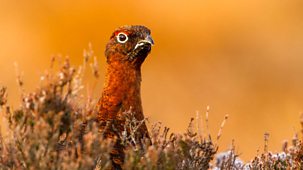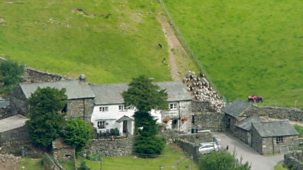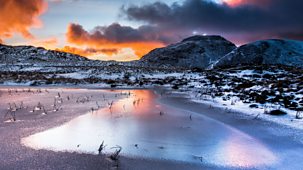
Shorts: The Fens: Horses
Hidden away in the most easterly part of the British Isles are the Fens of East Anglia; a landscape of big skies and distant horizons, of wild wetlands and fertile farmland. \nWater has always been the driving force here; its ebb and flow has shaped the fens for thousands of years. \nThe ancient wetlands covered hundreds of square miles and overflowed with wildlife. Today, well over 90% has gone, drained over the centuries and converted into farmland. Yet despite these changes, it’s still possible to glimpse the richness of those wetlands. \nEvery winter, thousands of migrating whooper swans return to the flooded pastures of the Ouse Washes from their Arctic breeding grounds. Here, they join thousands of other waterfowl in one of Britain’s greatest wildlife gatherings. \nOn the Welney Wetlands, spring sees ‘mad’ March hares boxing over mates. It was once thought these bouts were male hares boxing for dominance, but it’s often the females throwing the punches to fend off the attentions of over-eager suitors. \nIn the murky waters of the River Ouse, young eels or elvers are nearing the end of their 3,000-mile migration across the Atlantic, heading upstream into quite fenland backwaters. For 20 years they will feed and grow before making the return journey back across the Atlantic to the Sargasso Sea to breed and so complete their remarkable life-cycle. \nWicken Fen is one of the few fens that have never been drained. Well over nine thousand species jostle for space amid the reeds and sedges of this unique reserve …the greatest diversity of wildlife found anywhere in Britain. \nIn summer, devious cuckoos try to sneak their own eggs into the nests of reed warblers and then leave these unsuspecting hosts to raise their chicks. By the time it is fully grown, a cuckoo chick is eight times heavier than its overworked foster-parents! \nThese remnants of the ancient wetlands are now the focus for major efforts to return parts of the fens to their former glory. \nEuropean cranes disappeared from Britain four hundred years ago as the wetlands they relied on were drained. It‘s taken years of hard work to re-create the right conditions that enticed these elegant birds back here to breed. This year the Welney Wetlands saw the first crane chick to be raised here since Elizabeth the First was on the throne! \nOn Wicken Fen, tough Konik ponies have been imported from Poland to help convert abandoned farmland back into wild meadows. With their selective grazing and by breaking up the hard-packed soil as they dust bathe, the hundred-strong herd is quietly restoring this landscape.\nAnd water buffalo have been brought over from the rice paddies of East Asia to Kingfishers Bridge Fen to help save one of Britain’s rarest plants, the water germander. By trampling channels through the reed beds and by bulldozing bankside vegetation, these gentle giants make the space that the tiny water germander needs to thrive. \nFor centuries, the wild resources of the fens; the reed beds and wildfowl, fish and eels all enriched the lives of fenlanders. \nTraditional crafts such as rush-weaving and roof-thatching still survive in quiet corners. Felicity Irons is one of the last rush weavers in Britain. It takes her all day to weave sixty feet of inch-wide rush plaits which are then stitched together to make baskets and matting. In the summer cutting season, she will scythe 10-foot lengths of rush from fenland riverbeds. On a good day, her team can harvest two tonnes of rushes, supplies to see them through the winter weaving season.\nToday, most of these ancient wetlands have disappeared, drained so the land could be farmed. This is the most productive land in the country because of the metres of thick peat laid down in the ancient marshes that now forms an extremely rich soil. \nFarmers here grow unusual crops; acres of yellow sunflowers produce seeds for bird-tables all over the country … and millions of orange pumpkins are gathered each autumn ready for Halloween celebrations – a major event in the Fens. \nAs winter approaches the water levels rise and the swans return to the flooded pastures \nIt’s the constantly shifting balance between water and land and the cycle of the seasons that gives rhythm to life on the fens. This ancient and ever-changing landscape supports the greatest diversity of wildlife found anywhere in Britain and enriched the lives of people for many generations.\nWhile much of the ancient fenland has been lost forever to the plough and the harvester, in a growing number of places it’s now possible to enjoy the true nature of these wild wetlands once again.
Source: BBC 2
Most recent episodes of A Wild Year
A Wild Year
Shorts: 3. The North York Moors: Birds
In the north east of England lies a wild and remote moorland: 550 square miles of windswept, heather-clad uplands and deep, sheltered valleys or dales. These are the North York ...
08-07-2025
BBC 2
A Wild Year
Shorts: The North York Moors
In the north east of England lies a wild and remote moorland. This ancient landscape of heather-clad uplands and sheltered dales is home to red grouse and tough moorland sheep.
01-07-2025
BBC 2
A Wild Year
Shorts: Pembrokeshire: Crab Fishing
It’s April, and in one the region’s most sheltered harbours, local crab fishermen are making the most of the ideal conditions.
30-06-2025
BBC 2
A Wild Year
Shorts: 3. The North York Moors: Sheep
In the north-east of England lies a wild and remote moorland. Five-hundred-and-fifty square miles of windswept heather-clad uplands and deep, sheltered valleys or dales. These a ...
26-06-2025
BBC 2
A Wild Year
Shorts: Pembrokeshire: Ramsey Island
It might be isolated, but Ramsey Island has enough attractions to ensure inhabitants stay here all year around, with seals to spot, surfing and plenty of sheep.
25-06-2025
BBC 2
A Wild Year
Shorts: Pembrokeshire: Puffins
A look at Pembrokeshire’s wild and rugged coast, where life is defined by the rhythm of the seasons and the power of the sea.
11-06-2025
BBC 2
A Wild Year
Shorts: The Fens: Bulrushes
The rivers of the Fens are an ideal place for bulrushes to prosper, and they’ve helped sustain an important and traditional local industry.
05-06-2025
BBC 2
A Wild Year
Shorts: The Lake District: Herding
It’s summer, and that means that means the hum of mowers cutting back the grass, and the buzz of shearing machines, as flocks of sheep are shorn, after being herded down f ...
04-06-2025
BBC 2
A Wild Year
Shorts: The Fens: Horses
Hidden away in the most easterly part of the British Isles are the Fens of East Anglia; a landscape of big skies and distant horizons, of wild wetlands and fertile farmland. \n ...
29-05-2025
BBC 2
A Wild Year
Shorts: 1. The Lake District: Swim
Bluebells, sailboats and Beatrix Potter are just some of what the Lake District offers over 16 million tourists who flock to the area every year – some are there to take t ...
28-05-2025
BBC 2
Most popular episodes of A Wild Year
A Wild Year
Shorts: 3. The North York Moors: Sheep
In the north-east of England lies a wild and remote moorland. Five-hundred-and-fifty square miles of windswept heather-clad uplands and deep, sheltered valleys or dales. These a ...
26-06-2025
BBC 2
A Wild Year
Series 1: 1. The Pembrokeshire Coast
In the far south west corner of Wales lies Pembrokeshire’s wild and rugged coast. Life on this ancient coastline is defined by the rhythm of the seasons and the power of t ...
08-11-2024
BBC 2
A Wild Year
Series 1: 3. The North York Moors
In the north east of England lies a wild and remote moorland - 550 square miles of windswept heather-clad uplands and deep, sheltered valleys or dales. These are the North York ...
22-11-2024
BBC 2
A Wild Year
Shorts: Pembrokeshire: Puffins
A look at Pembrokeshire’s wild and rugged coast, where life is defined by the rhythm of the seasons and the power of the sea.
11-06-2025
BBC 2
A Wild Year
Shorts: The Lake District: Herding
It’s summer, and that means that means the hum of mowers cutting back the grass, and the buzz of shearing machines, as flocks of sheep are shorn, after being herded down f ...
04-06-2025
BBC 2
A Wild Year
Shorts: 1. The Lake District: Swim
Bluebells, sailboats and Beatrix Potter are just some of what the Lake District offers over 16 million tourists who flock to the area every year – some are there to take t ...
28-05-2025
BBC 2
A Wild Year
Shorts: The Fens: Bulrushes
The rivers of the Fens are an ideal place for bulrushes to prosper, and they’ve helped sustain an important and traditional local industry.
05-06-2025
BBC 2
A Wild Year
Shorts: The Fens: Horses
Hidden away in the most easterly part of the British Isles are the Fens of East Anglia; a landscape of big skies and distant horizons, of wild wetlands and fertile farmland. \n ...
29-05-2025
BBC 2
A Wild Year
Shorts: Pembrokeshire: Crab Fishing
It’s April, and in one the region’s most sheltered harbours, local crab fishermen are making the most of the ideal conditions.
30-06-2025
BBC 2
A Wild Year
Shorts: 3. The North York Moors: Birds
In the north east of England lies a wild and remote moorland: 550 square miles of windswept, heather-clad uplands and deep, sheltered valleys or dales. These are the North York ...
08-07-2025
BBC 2





